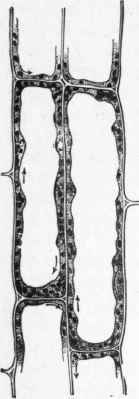2. Structure Of The Higher Plants. The Growth Of A Cell
Description
This section is from the book "Commercial Gardening Vol1", by John Weathers (the Editor). Also available from Amazon: Commercial Gardening, A Practical & Scientific Treatise For Market Gardeners.
2. Structure Of The Higher Plants. The Growth Of A Cell
The three plants already considered consist of a single cell, varying chiefly in size during their lifetime. Other plants, in an ascending scale of organization, consist of more or less numerous cells united in a variety of ways to form the plant body, either in the form of filaments, or flat plates of cells, as in freshwater or marine algae. The larger seaweeds form a tissue resembling stem and leaves, but a true stem and leaves are first met with in Mosses and Sphagnum. The Ferns are still more highly organized, by having true roots, stems, and leaves. The flowering plants are the most highly organized, and gardeners are chiefly concerned with them. The tiny Duckweeds, which cover still ponds in summer, are flowering plants of very exceptional structure, for they consist merely of a small mass of green cells, with one or more root hairs from the under side. The smallest of all (Wolffia arrhiza) has not even a root hair. The tallest tree and the smallest plant, amongst flowering subjects, consist alike of an aggregation of cells, built up in some definite form, according to the kind.
A full knowledge of plants may be obtained by a study of protoplasm and its protective covering - the cell wall - together with their behaviour when acted upon by light, heat, air, and moisture. A very young cell may be taken from the leaf of an apple tree, when beginning to unfold. It may be oval or nearly round. Under a high power of the microscope the wall appears double, but each individual has its own wall, and the other is the wall of the cells that abut on the one under examination. The interior at first is entirely filled with protoplasm, in the centre of which is a denser, oval body - the nucleus - consisting of a granular groundwork of protoplasm, denser at its margin, and having a fibrillar network of granules embedded in it. The nucleus plays a very important part in the division of full-grown cells. As the cell increases in size, cavities make their appearance in the protoplasm, filled with cell sap and air, and this continues till the cavities unite and the protoplasm can only form a lining to the wall, with a few bridles connecting it with the layer of protoplasm surrounding the nucleus in the centre (fig. 3). Streaming movements of the protoplasm may often be observed in the living cells of various plants (the direction being indicated by arrows in fig. 2). The large granules to be seen embedded in the protoplasm are chlorophyll or leaf green. The further history of this cell depends on whether the tissue requires more cells or not for its full development. If it does, then the nucleus elongates into spindle form, the protoplasm forms a mass at each end of the spindle, the two masses being joined by threads. A layer of protoplasm (the cell plate) then extends across the cell from wall to wall, and from this layer a new partition is formed simultaneously and continuously. Thus two cells are formed. The common partition later on splits into two, so that each daughter cell has its own complete wall and a half of the original nucleus (fig. 4). If the full-grown cell does not intend to divide, the remainder of the protoplasm is used up in thickening the walls, or is drafted away into younger and growing cells. The empty cell is now dead for all time coming, though it may exist for a thousand years or more, if it forms part of the stem of a giant Sequoia gigantea of California. The cell wall at first consists of cellulose, a substance closely allied to starch and sugar, all three being made up of the chemical elements carbon, hydrogen, and oxygen, in different combinations, and all becoming black when burned.

Fig. 2. - Protoplasm Streaming in Cells of Vallisneria in Direction of Arrows.

Fig. 3. - Isolated Cells (1 and 2) with and (3) without Nuclei - highly magnified.

Fig. 4. - Changes in the Protoplasm of the Cell Nucleus during its Division.
1, The Nuclear Fibrils distributed through the whole Nucleus. 2, The broken-up Nuclear Fibrils arranged as the Nuclear Plate. 3, The elements of the plate separating from one another. 4, The same elements forming two skeins at the poles of the Spindle. (After Guignard.) Very highly magnified.
Continue to:


